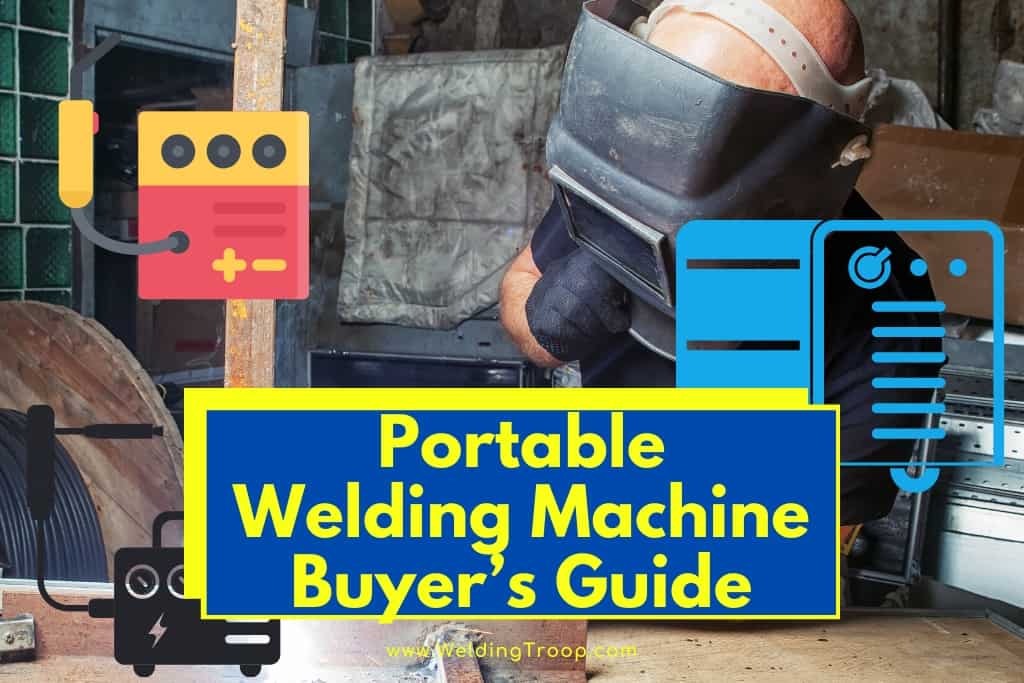Welding has enabled the construction of skyscrapers, the manufacture of automobiles, the fabrication of aircraft, and so much more. Incredibly, today’s technology allows you to perform welding in your garage, in your shop, or even in your backyard. So, whether you need to weld pieces of a custom motorcycle frame or just a broken hinge, a portable welding machine puts the power of welding in your hands.
So, what should you look for when buying a portable welding machine? This essential buyer’s guide will walk you through the key attributes that matter when deciding which portable welding machine best suits your needs, including:
- Performance
- Power input
- Power output
- Metals it can weld
- Size and weight
With so many options to choose from, and manufacturers throwing every specification in the book at you, it is easy to get lost in the maze of information clutter and make the wrong decision. This is why the first step in buying a portable welding machine is making sure that you genuinely understand what welding is, how it works, and perhaps most importantly, what sets the different welding methods apart.
Table of Contents
5 Things to Look for When Buying a Portable Welding Machine
An experienced welder may know precisely what to look for in a portable welding machine, perhaps even down to a specific brand and model number. For the rest of us, however, buying a portable welding machine can prove to be a daunting task without having the necessary information. An informed decision is a wise decision, particularly when it comes to deciding on welding equipment.
Related reading: How many types of welding machines are there and their uses?
Welding is more than merely joining two pieces of metal together. When metals are welded, they are subjected to such high temperatures that they melt and reach a molten (liquid) state. Typically a filler metal is added to this molten mixture (referred to as a weld pool or puddle), and when the pool cools and hardens, the new weld has the same properties as the parent metals.
This is why welding has played such a vital role in industries like manufacturing, assembly, and fabrication. When a weld is made, there is much more on the line than just forming a joint between two pieces of metal, so welding equipment matters.
Relate reading: What Is the Difference Between Welding and Fabrication?
Portable Welding Machine Buying Tips
There are several portable welding machine attributes and characteristics to consider when making a purchasing decision. As you are about to see, certain machine qualities relate directly to welding performance and operability, while others contribute to the overall user-friendliness of the machine. By weighing and balancing these various factors against your needs and requirements, you can select from a narrowed-down field of viable options and make the right choice.
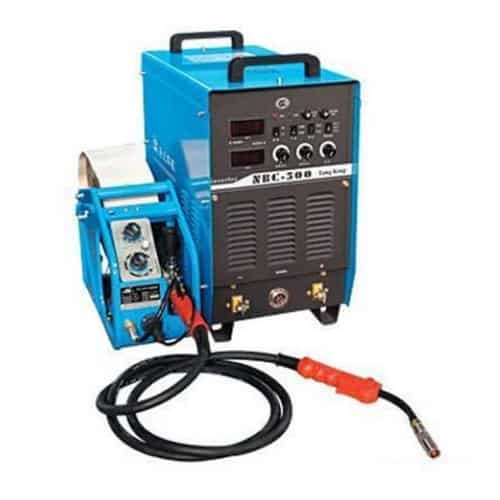
Since most welding machines are of the arc welding variety, this article will examine portable machines that perform the following types of welding:
- Stick welding (also known as shielded metal arc welding, or SMAW)
- Flux-cored arc welding (FCAW)
- Gas metal arc welding (GMAW), sometimes referred to as MIG welding
- Tungsten metal arc welding (GTAW), sometimes referred to as TIG welding
Related reading: 5 Key Advantages of Arc Welding Over Gas Welding
BUYING TIP #1: Welding Processes
Virtually every major manufacturer of arc welding equipment offers specialized machines that perform a specific type of welding. In other words, there are MIG-only machines, TIG-only machines, and so on. While this may be acceptable if, with all certainty, you will only perform one type of arc welding, by going this route, you will limit yourself to only those welding applications that are compatible with your machine.
What if there is a good possibility that you will need to perform different types of welding? Rather than having two or three welding machines sitting side by side in your workshop, wouldn’t it be great if there was one machine that was equally adept at performing multiple types of welding?
Multi-Process Welding Machines
Multi-process welding machines are capable of transitioning from one form of arc welding to another with minimal setup. From an operational standpoint, welding modes can be switched without changing the external power source.
At a bare minimum modern multi-process machines are capable of performing two types of arc welding, but the majority can perform all four primary arc welding methods: stick (SMAW), flux-cored (FCAW), MIG (GMAW) and TIG (GTAW). Despite their compact size, portable multi-process welding machines contain all the terminals, inputs, and hookups needed to connect the various accessories needed for each type of welding.
Many of today’s multi-process machines incorporate sophisticated programming that automatically detects when certain accessories are connected to the machine; for instance, sensing when a MIG gun has been connected and automatically regulating the speed at which the electrode wire is fed. They also feature advanced technology that assists the operator when transitioning from one thickness to another to optimize weld quality.
Related reading: 9 Different Types of Welding Processes & Their Advantages
BUYING TIP #2: Power Input
The overwhelming majority of portable welding machines run on electricity, so input power, or available power supply, is a critical consideration. As a general rule, the more welding power that your portable welding machine is capable of generating, the higher its electricity needs. To illustrate, an entry-level multi-process machine operating on standard 120-volts can perform light industrial duties such as:
- Light construction jobs
- Light fabrication
- Maintenance and repair
- Mechanical contractor work
Upgrading the input power to 220-volts increases the welding capabilities of the machine with the addition of autobody work and jobs around the farm, while jumping up to three-phase, 460-volt power elevates portable welding machines into the heavy industrial class of duties, including:
- Shipbuilding
- Heavy construction
- Railroad work
- Truck and trailer manufacturing
- Power generation plants
The key takeaway concerning input power is to assess the types of welding projects you will be undertaking carefully and then align these with the power requirements of the portable welding machines you are considering. If your welding needs fall within the light industrial category, you need not bother looking at machines that operate at 460-volts or higher. On the other hand, if your work requires medium to heavy industrial welding, a 120-volt machine simply will not do.
Multi-Voltage Welding Machines
Perhaps your workshop has a readily available 220-volt, 30-amp hookup, but what if your second workspace or job site does not? Fortunately, there are several portable welding machines with the capability of running on dual or multiple voltages. A standard configuration is 120/240, which means that the machine can operate on either standard 120-volts or 240-volts if it is available. It is vital to bear in mind, however, that a machine’s capabilities will be enhanced at the higher voltage.
Beyond 120/240, there are portable welding machines that operate on 240/460-575 (three-phase) volts, meaning that the minimum voltage for it to function is 240-volts, with the capability of operating at 460-volts and even 575-volts with corresponding increases in welding performance.
Related reading: How Many Amps Do I Really Need for a MIG Welder?
BUYING TIP #3: Power Output
When it comes to welding power, several measurables are used to indicate a portable welding machine’s capabilities. The one figure that seems to be the most commonly used is a machine’s amperage, as it is a number that relates to the amount of electrical current that is cycling through the welding machine and the workpiece.
As a general rule, the higher the amperage at which a welding machine is running, the deeper that the arc will penetrate the workpiece as it melts the base metal and creates the weld. Thus, a welding machine with a lower amperage range will produce shallower welds than a machine with a higher amperage rating.
To illustrate, here are a couple of amperage ranges and the corresponding thicknesses that can be welded:
| AMPERAGE | STAINLESS STEEL THICKNESS | ALUMINUM THICKNESS |
|---|---|---|
| 30-140 amps | 3/16 inch maximum | 14 gauge (5/64 inch) maximum |
| 30-230 amps | 3/8 inch maximum | 3/8 inch maximum |
BUYING TIP #4: Metal Types and Thicknesses
If you are employed in a welding trade or plan to utilize your welding skills in a particular field, then you may have a good idea of the type of welding work you will be performing. Specifically, the more you know about the types of metals you will be welding, along with their characteristics, the better you can gauge which portable welding machines will best suit your needs.
Many welding machine manufacturers highlight the types of metals and their respective thicknesses that their machines can weld. This spec sheet prominently places this data at the top of the first page so that at a glance, you know that this particular model can TIG weld steel ranging in thickness from .020 inches to 3/16 inches, and stick weld steel from 16 gauge to 3/8 inches in thickness.
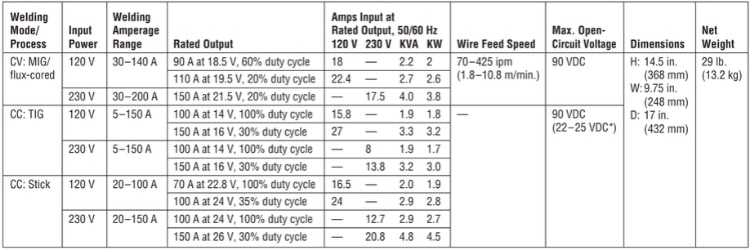
As you saw earlier, knowing your workpieces can also help determine the amperage range you need to target, which is another useful way to choose the right welding machine.
BUYING TIP #5: Size and Weight
Portability is a relative term, and its meaning will vary from person to person, particularly for welding machines. For a hobbyist or artist who may, on occasion, perform welding services offsite, a 29-pound, 110-volt welding machine would fit in the trunk of just about any vehicle and could easily be loaded and unloaded.
On the other hand, a 122-pound welding machine would push the limits of loading and unloading by a single person and would undoubtedly require the use of a dolly or cart. In the case of the MIG and TIG welding methods, not only would the welding machine need to be portable, but the bottled gas would need to be portable, as well.
Although the size and weight of a welding machine may be secondary considerations to its performance value, if indeed the machine will be regularly transported to and fro, then size and weight are factors to be considered.
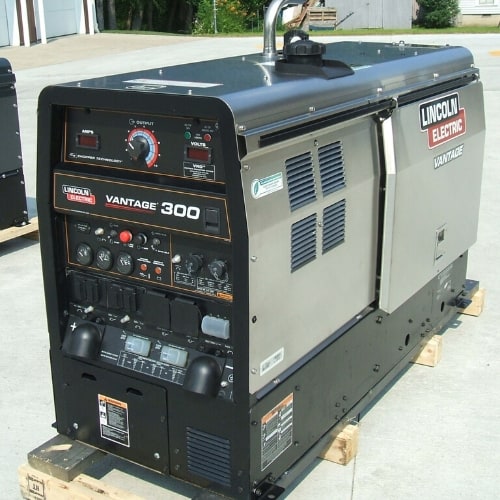
Related reading: How Much Does an Average Lincoln Welding Machine Weight?
How to Choose and Buy a Portable Welding Machine
For those looking to buy their first portable welding machine, there is good news and a bit of not so good news. The good news is that there is an incredible range of machines to consider, from those that perform a specific type of welding technique to multi-process machines capable of performing multiple types of welding.
The not so good news is that there are so many different options that it can be challenging to distinguish one manufacturer’s machine from another’s. All the specifications and configurations can become a jumbled mess of numbers, letters, and codes that would confuse even the most experienced welders. Fortunately, there are a few tips to guide you through the decision-making process.
While it is impossible to master everything there is to know about portable welding machines, you can help yourself filter out unsuitable machines and narrow down the field to a few selections. Ultimately, the decision as to which portable welding machine to buy should be guided by your immediate and future project needs. Here are a few guidelines to consider:
- What types of metal will you be welding? How thick are the workpieces?
- In what environment will you be welding (e.g., a shop, a garage, an outdoor construction site)?
- What types of welding positions do you anticipate working (e.g., flat, horizontal, vertical, overhead)?
- Will the welds be visible, and are weld aesthetics important?
- Is welding speed important?
Related reading: How to Start & Grow A Welding Business In 11 Steps
What Types of Metal do You Plan to Weld?
The base metal, or workpiece, is to a welder as a canvas is to a painter. If it is a metal that conducts electricity, then it can be welded. But not all metals can be welded expertly by all four of the arc welding methods. The reality is that each method is particularly suited for specific types of metals.
Related reading: Can You Weld Magnets? Or Would It Ruin Them?
What complicates things is that there is considerable overlap regarding welding methods and their compatible metals. Furthermore, certain metals can only be welded using several of the arc welding methods. Once again, knowing your workpieces will help you determine which welding machine is best for you.
Here is a table that breaks some of this down:
| Metal Type | MIG Welding | Stick Welding | TIG Welding |
|---|---|---|---|
| Steel | X | X | X |
| Stainless Steel | X | X | X |
| Aluminum Alloys | X | X | |
| Cast Iron | X | ||
| Copper | X | ||
| Brass | X | ||
| Exotic Metals | X |
Metal Thickness
Aside from the type of metal that is being welded, the thickness of the workpiece is also a critical factor in determining the right welding method to use. Some arc welding techniques are better suited for thicker materials while others excel at welding thinner pieces. There are also techniques that, with the proper setup, can weld virtually any thickness.
Stick and flux-cored welding are well-suited for thicker workpieces, and MIG welding is ideal for thinner metal pieces. For a frame of reference, here is the thickness of commonly welded materials and items:
- Auto body parts – 3/16 inch or less
- Bicycles and lawnmowers – 1/16 inch
- Boats, cars, and motorcycles – 1/16 to 1/8 inch
- General to heavy repairs – 3/16 to 1/4 inch
- Farm and ranch jobs – 5/16 to 3/8 inch
In What Types of Environments do you Plan to Weld?
The working environment is another essential factor to be considered when choosing a portable welding machine. Not all welding jobs can be performed in the controlled confines of a workshop or garage. Due to the size or location of the workpiece involved, working indoors at all may not be feasible.
For instance, on a farm or in an agricultural setting, there are numerous types of large, heavy equipment being used daily, and occasionally, spot repairs need to be performed. Many of these maintenance jobs require welding. MIG and TIG welding are not well suited for outdoor welding jobs because even the slightest breeze can disrupt the protective envelope formed by the shielding gas, and faulty welds can result.
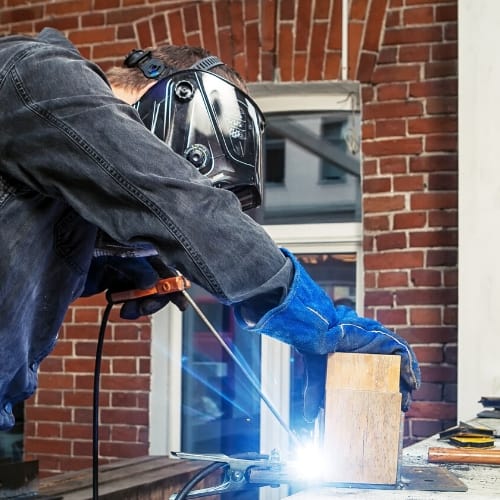
Even if your primary workspace is indoors, there are still important things to consider as far as planning your welding operations:
- Do you have proper ventilation, especially for flux cores?
- Do you have adequate space for bottled gas (MIG and TIG), with the possibility that you may need to store multiple bottles of different gases and mixtures?
- Does your facility have adequate spacing around the work area to minimize fire and injury risk?
Related reading: Can You Arc Weld Outside? | Understanding welding Outdoors
What Welding Positions do you Anticipate?
While most arc welding operations will take place on a workbench with the workpiece laying flat and horizontal, there may be instances when this ideal orientation simply is not feasible. Sometimes referred to as “out of position welding,” there are welding jobs that need to be performed onsite and in less than ideal conditions.
For instance, there may be occasions when overhead or vertical welding must be performed. Flux-cored welding is the ideal method for this type of welding as it utilizes a continuously fed wire that has flux (and shielding gas) incorporated into the electrode.
The other arc welding methods can certainly be adapted to perform out of position welding, but they all have their limitations and challenges as far as equipment set up. MIG and TIG welding will require that the shielding gas cylinders be located somewhere in the vicinity of the workspace for hookup to the welding machine, which could impede out of position welding.
Are Weld Aesthetics Important?
While all welds must be strong and uncompromised without exception, there are instances where welds also need to have a high aesthetic appeal. In other words, they need to be structurally sound while looking good. The one method that meets these requirements is TIG welding, which is also widely considered to be the most challenging technique to master because of its demanding two-handed operation.
In the hands of a highly skilled and experienced welder, any welding device can be made to produce uniform welds. But certain limitations are simply beyond the operator’s control, and this is why TIG welds are head and shoulders above the rest in terms of visual appeal.
Related reading: The Problem with Weld Spatter – and How to Stop It
Does Welding Speed Matter?
For the same reasons that TIG welding produces the most beautiful weld beads, it is the slowest arc welding process by far. If speed is an important attribute of your welding work, then TIG welding is not the answer. Rather, MIG or flux-cored welding may be the best place to start as far as selecting the right portable welding machine for your welding needs.
An experienced stick welder can also make quick work of welding, but the frequency of electrode (stick) changes can prolong the time to complete the whole job.
Portable Welding Machine Recommendations
With so many options to choose from, making a well-informed purchasing decision can seem like a daunting task. The following portable welding machine recommendations will hopefully steer you in the right direction and give you an indication of popular models and their specifications. To make things easier, these options are broken down into several categories.
Best Portable Welding Machine – Standard 110-Volts
For the hobbyist, artist, or occasional do-it-yourselfer, a portable welding machine that operates on standard 120-volt power can be used virtually anywhere there is a wall outlet. Despite operating on regular household voltage, many of these machines still pack a potent welding punch and are more than capable of producing a quality weld.
- Etosha MIG 140 – This 110-volt welding machine performs both MIG and flux-cored welding methods. Weighing a mere 15 pounds, this is about as portable as a welding machine can get while still delivering high performance. With a maximum output of 140 amps, the Etosha MIG 140 is capable of welding mild steel up to a thickness of 3/16 inches. As a bonus, a welding mask and gloves are included.
Best Entry-Level Portable Welding Machine
With so many resources available online, including articles and how-to videos, you can learn the basics of welding from the comfort of your garage, workshop, or studio. Welding machine manufacturers continue to incorporate advanced features that make welding simpler and easier, even for beginners. With a little bit of know-how and a willingness to practice, you can start developing foundational welding skills on your own time.
- Forney Easy Weld 261 – This is a quality MIG welding machine that is ideal for novice welders. MIG welding is considered the easiest arc welding method to learn, mainly because the MIG welding gun is trigger-activated: pull the trigger to weld and release the trigger to stop. Electrode wire is automatically fed from a spool. This lightweight, portable welding machine weighs 19 pounds and can weld workpieces up to 1/4 inch thick. It also performs flux-cored welding.
Best Multi-Process Portable Welding Machine
As the name suggests, a multi-process welding machine offers multiple arc welding methods from the same machine, using the same power source. The primary benefit of owning one of these machines is being able to weld the broadest range of metal types possible without having to switch machines. Switching from one welding method to another is seamless and can be done in a matter of minutes.
- Weldpro 200 Amp Inverter Multi-Process Welder – This compact multi-process welding machine offers the four arc welding methods – MIG, flux-cored, TIG, and stick – in one machine. Its dual-voltage (220-volts/110-volts) capability allows you to perform high-quality welding on the go, regardless of available power supply.
It is extremely portable at 30 pounds and is capable of welding a wide range of workpiece thicknesses with its 200 amp rating:
- Stick welding: 14 gauge to 5/16 inches
- MIG welding: 19 gauge to 3/16 inches
- TIG welding: 25 gauge to 1/4 inches
Best Semi-Professional Portable Welding Machine
Of the four primary arc welding methods, TIG is widely considered the most difficult to learn and master. It can be applied to the broadest range of workpiece types and is highly regarded for its unique ability to create joints that have the same strength and anti-corrosion characteristics as the parent metals. It is also the method that produces the highest quality beads with the greatest aesthetic value and is therefore popular with artists and artisan welders.
- Everlast PowerTIG 200DV Welder – This is a multifunctional portable TIG welding machine that offers tremendous flexibility and performance in a compact, user-friendly design. With its 200-amp rating, this TIG welder features AC/DC welding with inverter technology, with a 5-amp start in DC and a 20-amp start in AC. This welder functions on 120-volt or 240-volt power.
Aside from the precision welding that is the hallmark of TIG welding, the Everlast PowerTIG 200DV also offers an incredible amount of welding power on a wide range of metal types:
- Steel: 5/16 inch maximum thickness in a single pass (240-volt)
- Steel: 1/2 inch maximum thickness in multiple passes (240-volt)
- Aluminum: 1/4 inch maximum thickness in a single pass (240-volt)
- Aluminum: 3/8 inch maximum thickness in multiple passes (240-volt)
In Conclusion
In so many ways, welding has revolutionized the way that things are manufactured and assembled, and portable welding machines put that same power into your hands. But how much of an informed decision you make when buying a portable welding machine for the jobs you will be performing and the types of metals you will be welding can be the difference between success and failure.
Whether your preferred welding method is MIG, TIG, stick, flux-cored, or all of the above, choosing the arc welding machine that perfectly suits your needs and abilities may prove to be one of the best decisions you ever made.
Here are some of my favorite tools & equipment´s
Thank you for reading this article. I hope it helps you find the most recent and accurate information for your welding project. Here are some tools that I use daily and hope you´ll also find helpful.
There are affiliate links, so if you do decide to use any of them, I´ll earn a small commission. But in all honesty, these are the exact tools that I use and recommend to everyone, even my own family. (NO CRAP)
To see all my of most up-to-date recommendations, check out this resource that I made for you!

